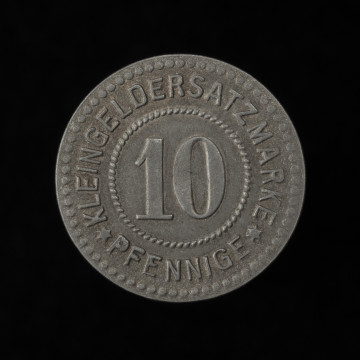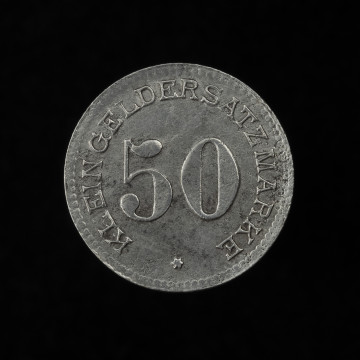
50 pfennig
1901 — 1925
National Museum in Szczecin
Part of the collection: Scrip
During the First World War, there was an evident shortage of small coins in the German money market. This was brought about by the actions of the Reich Bank, which pulled bullion coins out of circulation, but also by the attitude of the public, accumulating everything that had any value. Faced with a situation in which the circulation of money and retail payments was threatened, local governments decided to mint their own replacement currency. This needed to vary from the state issued currency, so it was often given specific shapes - squares, rosettes, ellipses, hexagons, or octagons, the latter of which was a fairly common form. It was different from official coinage, yet retained the design associated with a coin. The town of Darłowo opted for this particular form to serve as its replacement money, issuing denominations of 5 and 10 pfennig. The coins were struck in iron by the Münzprägeanstalt L. Chr. Lauer of Nuremberg. They represent a fairly common pattern of replacement money ordered by local authorities. The obverse field featured the issuer's coat of arms in a solid border and the issuer's name was placed around the rim. The design was surrounded by a mother-of-pearl ring, with stars, dots, rhombuses, or combinations of these incorporated as additional decoration. On the reverse, the mother-of-pearl frame carried the denomination and the designation. For the Darłowo issue, the designation was NOTGELD (emergency money). Metal replacement money, although ordered by many townships, counties and various other institutions, did not play a significant role in monetary circulation. Their issues were too small, and the growing collection of replacement money caused these coins to be removed from circulation as well. Mieszko Pawłowski
Other names
10 Pfennig, Notgeld
Author / creator
Object type
token coin
Technique
coining
Material
iron
Origin / acquisition method
purchase
Creation time / dating
Creation / finding place
Owner
Muzeum Narodowe w Szczecinie (1945- )
Identification number
Location / status

1901 — 1925
National Museum in Szczecin

1918
National Museum in Szczecin

1901 — 1925
National Museum in Szczecin
DISCOVER this TOPIC
National Museum in Szczecin
DISCOVER this PATH
Educational path